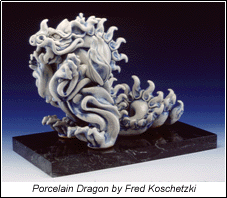| Monthly Tech-Tip | No tracking! No ads! | |
A Low Cost Tester of Glaze Melt Fluidity
A One-speed Lab or Studio Slurry Mixer
A Textbook Cone 6 Matte Glaze With Problems
Adjusting Glaze Expansion by Calculation to Solve Shivering
Alberta Slip, 20 Years of Substitution for Albany Slip
An Overview of Ceramic Stains
Are You in Control of Your Production Process?
Are Your Glazes Food Safe or are They Leachable?
Attack on Glass: Corrosion Attack Mechanisms
Ball Milling Glazes, Bodies, Engobes
Binders for Ceramic Bodies
Bringing Out the Big Guns in Craze Control: MgO (G1215U)
Can We Help You Fix a Specific Problem?
Ceramic Glazes Today
Ceramic Material Nomenclature
Ceramic Tile Clay Body Formulation
Changing Our View of Glazes
Chemistry vs. Matrix Blending to Create Glazes from Native Materials
Concentrate on One Good Glaze
Copper Red Glazes
Crazing and Bacteria: Is There a Hazard?
Crazing in Stoneware Glazes: Treating the Causes, Not the Symptoms
Creating a Non-Glaze Ceramic Slip or Engobe
Creating Your Own Budget Glaze
Crystal Glazes: Understanding the Process and Materials
Deflocculants: A Detailed Overview
Demonstrating Glaze Fit Issues to Students
Diagnosing a Casting Problem at a Sanitaryware Plant
Drying Ceramics Without Cracks
Duplicating Albany Slip
Duplicating AP Green Fireclay
Electric Hobby Kilns: What You Need to Know
Firing Clay Test Bars
Firing: What Happens to Ceramic Ware in a Firing Kiln
First You See It Then You Don't: Raku Glaze Stability
Fixing a glaze that does not stay in suspension
Formulating a body using clays native to your area
Formulating a Clear Glaze Compatible with Chrome-Tin Stains
Formulating a Porcelain
Formulating Ash and Native-Material Glazes
G1214M Cone 5-7 20x5 glossy transparent glaze
G1214W Cone 6 transparent glaze
G1214Z Cone 6 matte glaze
G1916M Cone 06-04 transparent glaze
Getting the Glaze Color You Want: Working With Stains
Glaze and Body Pigments and Stains in the Ceramic Tile Industry
Glaze Chemistry Basics - Formula, Analysis, Mole%, Unity
Glaze chemistry using a frit of approximate analysis
Glaze Recipes: Formulate and Make Your Own Instead
Glaze Types, Formulation and Application in the Tile Industry
Having Your Glaze Tested for Toxic Metal Release
High Gloss Glazes
Hire Us for a 3D Printing Project
How a Material Chemical Analysis is Done
How desktop INSIGHT Deals With Unity, LOI and Formula Weight
How to Find and Test Your Own Native Clays
I have always done it this way!
Inkjet Decoration of Ceramic Tiles
Is Your Fired Ware Safe?
Leaching Cone 6 Glaze Case Study
Limit Formulas and Target Formulas
Low Budget Testing of Ceramic Glazes
Make Your Own Ball Mill Stand
Making Glaze Testing Cones
Monoporosa or Single Fired Wall Tiles
Organic Matter in Clays: Detailed Overview
Outdoor Weather Resistant Ceramics
Painting Glazes Rather Than Dipping or Spraying
Particle Size Distribution of Ceramic Powders
Porcelain Tile, Vitrified Tile
Rationalizing Conflicting Opinions About Plasticity
Ravenscrag Slip is Born
Recylcing Scrap Clay
Reducing the Firing Temperature of a Glaze From Cone 10 to 6
Setting up a Clay Testing Program in Your Company
Simple Physical Testing of Clays
Single Fire Glazing
Soluble Salts in Minerals: Detailed Overview
Some Keys to Dealing With Firing Cracks
Stoneware Casting Body Recipes
Substituting Cornwall Stone
Super-Refined Terra Sigillata
The Chemistry, Physics and Manufacturing of Glaze Frits
The Effect of Glaze Fit on Fired Ware Strength
The Four Levels on Which to View Ceramic Glazes
The Majolica Earthenware Process
The Potter's Prayer
The Right Chemistry for a Cone 6 MgO Matte
The Trials of Being the Only Technical Person in the Club
The Whining Stops Here: A Realistic Look at Clay Bodies
Those Unlabelled Bags and Buckets
Tiles and Mosaics for Potters
Toxicity of Firebricks Used in Ovens
Trafficking in Glaze Recipes
Understanding Ceramic Materials
Understanding Ceramic Oxides
Understanding Glaze Slurry Properties
Understanding the Deflocculation Process in Slip Casting
Understanding the Terra Cotta Slip Casting Recipes In North America
Understanding Thermal Expansion in Ceramic Glazes
Unwanted Crystallization in a Cone 6 Glaze
Using Dextrin, Glycerine and CMC Gum together
Volcanic Ash
What Determines a Glaze's Firing Temperature?
What is a Mole, Checking Out the Mole
What is the Glaze Dragon?
Where do I start in understanding glazes?
Why Textbook Glazes Are So Difficult
Working with children
Fighting the Glaze Dragon
Description
At Digitalfire we promote the idea of understanding and formulating your own glazes so you have control rather than relying on suppliers or the trade in glaze recipes.
Article
With a S-W-O-R-D
Software and the Internet

Internet resources for ceramics are growing every day. You can participate in discussions with thousands of people many of whom have years of experience. Check our links page for a springboard into the ceramic internet, use the search field on our home page to search the resources of this site.
- INSIGHT for Windows, Linux or Macintosh is an glaze calculator and empowers you to take control of your glazes with confidence and power you never dreamed possible. It is totally focused on doing classic ceramic glaze calculations at lightning speed and you can do two at once to compare them side-by-side. It is ideal for education (i.e. demonstrating the concepts of unity, analysis, formula, and LOI are easy).
- Insight-live.com is a online SQL database system that maintains unlimited materials, oxides, recipes, test procedures, test results, physical property, reference, picture and people data in your private account.

- Our Digitalfire Reference Database will prepare you for the world of glaze calculations and introduce you to simple yet effective physical testing you can do now. It is closely integrated with our software and helps readers intelligently decide when ceramic calculations are appropriate and when they should give way to physical testing.
Ancient potters prayed to the kiln god to watch over their firings, today they would likely take advantage of available technology.
- The 'need-know-only' culture in industry needs a funeral. You need in-house expertise, don't rely on suppliers or consultants only.
- That storage room full of mysterious materials bought just to test failed recipes is a monument to a passive mindset that needs to die among potters.
- Understand glazes and materials, don't just use them. What is in each material and why it is there? The implications of removing or altering each ingredient? Changing the firing? Using with oxides and opacifiers?

- Stop spinning your wheels. Stop having failures and learning nothing from them.
- Develop opinions.
Abandon Obsolete Thinking

In past we had glaze books filled with cantankerous recipes. Now it is better to have only a few base glazes and adjust these to produce all the needed effects. You should be able to draw a 'family tree' of all your recipes showing how they interrelate and the rationalization for specific alterations.
- It is impossible to control 50 recipes. It is much better to start with one base glossy and one base matte, preferably closely related. This approach allows you to concentrate your efforts on understanding and perfecting the properties of one base. Improvements to the base will benefit every glaze derived from it. You'll be able to throw out all those bags of materials you bought just to test recipes that never worked.
- A recipe and the documentation that rationalizes it are inseparable entities where beginners are the recipients. Unfortunately the very ones who trade most are those who have not reached the 'want-to-know-why' stage. There are 'ethics' giver and receiver should not ignore. Documented recipes prove the author is conscientious and willing to field questions to help users adapt. Recipients willing to 'understand' and adjust demonstrate a grasp of the true nature of ceramic processes. Poor glazes can injure people physically.
- Reliance on 'Textbook recipes' is a constant impediment to your progress. They will control you instead of you them, they'll throw good results almost totally to chance, they are an impediment to your progress. They will stand as a barrier between you and getting an understanding, being in touch. Like raising and training a puppy from birth, it will just be easier to create your own recipes.
Good Record-keeping
- Did you do a lot of testing in the past 15 years? Where are the results? It is a shame not to learn from your own past. An account at insight-live.com completely replaces your existing record keeping system. With it you can store a life time of ceramic related data in an organized, searchable, reportable format. Every piece of paper on your desk, in your filing cabinets could be in insight-live where you can find it.
- Instead of searching filing cabinets and boxes, you should be searching your database.
- Your plant should have documentation on each material used, there should be notes that clearly rationalize advantages and disadvantages compared to alternative products and factors about the material that require extra diligence in production and testing to assure quality.

Determination for Technical Excellence
- In the past our consciences allowed us to put 90% of our effort on appearance and 10% on technical issues. Accept your responsibility to produce ware that is beautiful but also hard, strong, dense, acid resistant, thermal shock resistant, chip resistant, and pinhole and craze free.
- Don't be intimidated by the simple techniques and tools that are within your reach now.
You might consider The Potters Prayer (see links) if our solutions do not work!
Related Information
Links
| Articles |
G1214M Cone 5-7 20x5 glossy transparent glaze
This is a base transparent glaze recipe developed for cone 6. It is known as the 20x5 or 20 by 5 recipe. It is a simple 5 material at 20% each mix and it makes a good home base from which to rationalize adjustments. |
| Articles |
The Potter's Prayer
A prayer for potters who wish to continue down the road of text book glaze recipes, never really getting what they want, never getting control. |
| By Tony Hansen Follow me on        |  |
Got a Question?
Buy me a coffee and we can talk

https://digitalfire.com, All Rights Reserved
Privacy Policy
